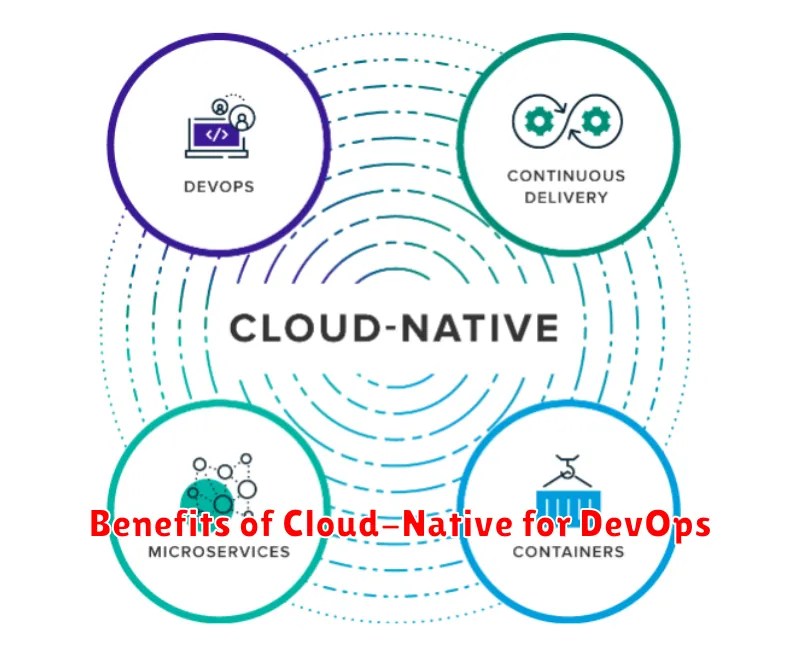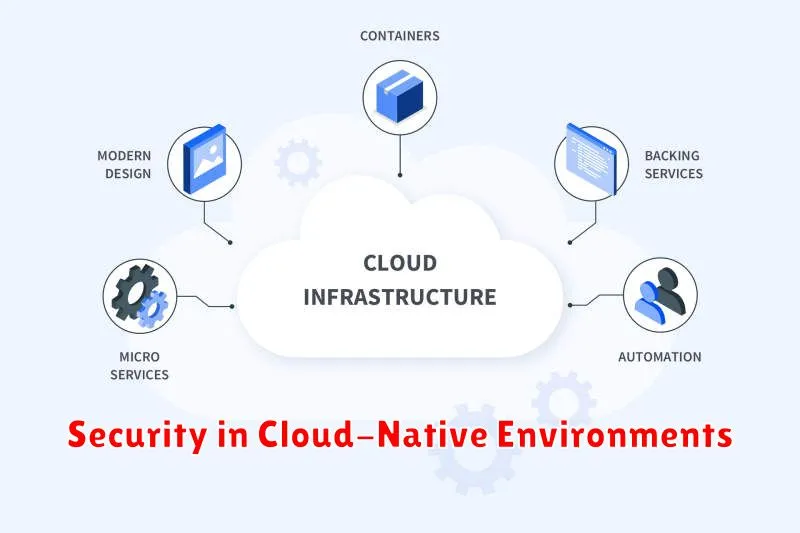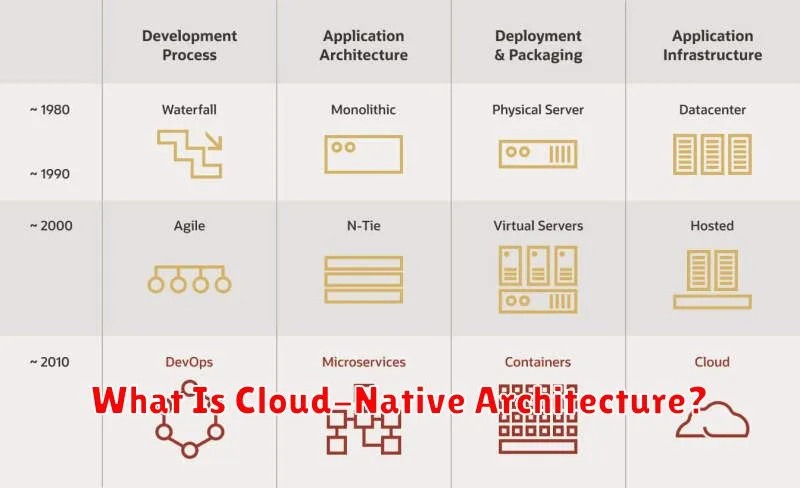In today’s rapidly evolving technological landscape, cloud-native architecture has emerged as a transformative approach to software development. It represents a significant shift from traditional monolithic applications to more agile, scalable, and resilient systems. Understanding what constitutes cloud-native architecture is crucial for organizations seeking to leverage the full potential of the cloud and gain a competitive edge. This article will delve into the core principles, benefits, and key components of cloud-native architecture, providing a comprehensive overview of this essential paradigm.
Cloud-native architecture is more than just deploying applications in the cloud; it’s about designing and building applications specifically to thrive in a cloud environment. This involves embracing key concepts such as microservices, containers, DevOps, and continuous delivery. By adopting cloud-native principles, organizations can achieve greater agility, scalability, resilience, and cost-efficiency in their software development and deployment processes. This introductory exploration will lay the groundwork for a deeper understanding of the cloud-native ecosystem and its implications for modern software development.
Defining Cloud-Native Principles
Cloud-native principles guide the design and development of applications specifically for cloud environments. These principles emphasize leveraging cloud capabilities to achieve scalability, resilience, and agility.
Automation is a core principle, enabling efficient management and orchestration of applications and infrastructure. This includes automated deployments, scaling, and self-healing capabilities.
Loose coupling between services ensures that failures in one part of the system do not cascade and impact others. Microservices architecture is often employed to achieve this decoupling.
Observability is crucial in cloud-native applications. Robust monitoring, logging, and tracing provide insights into system behavior and facilitate troubleshooting.
Microservices, Containers, and APIs
Cloud-native architecture heavily relies on microservices, containers, and APIs. Microservices break down applications into small, independent, and loosely coupled services. This allows for independent scaling, deployment, and updates, increasing agility and resilience.
Containers package these microservices and their dependencies into isolated units, ensuring consistent execution across different environments. This portability simplifies deployment and management. Docker is a popular containerization technology used in cloud-native development.
APIs (Application Programming Interfaces) enable communication between microservices. They define how different services interact, allowing them to share data and functionality. This decoupling further enhances flexibility and maintainability.
12-Factor App Methodology Explained
The 12-Factor App methodology is a set of best practices for building software-as-a-service (SaaS) applications that are optimized for modern cloud-native environments. It provides a framework for creating portable, resilient, and scalable applications that can be easily deployed and managed.
These 12 factors encompass various aspects of application development, including codebase, dependencies, configuration, backing services, build, release, run, processes, port binding, concurrency, disposability, and logs. Adhering to these principles allows developers to create applications that are platform-agnostic and can be readily deployed to various cloud platforms.
Key advantages of adopting the 12-Factor App methodology include increased developer productivity through automation and streamlined workflows, enhanced application portability, and improved scalability and resilience.
By implementing these factors, development teams can create applications that are better suited for the dynamic and distributed nature of cloud environments. This methodology promotes the use of declarative formats for setup automation, which reduces time and effort spent on configuration and deployment. It also encourages treating backing services as attached resources, which enhances flexibility and portability.
Benefits of Cloud-Native for DevOps

Cloud-native architectures offer significant advantages for DevOps practices. Automation is a key benefit, enabling streamlined deployments, scaling, and infrastructure management. This reduces manual intervention and increases efficiency, leading to faster release cycles.
Resilience is another crucial advantage. By leveraging microservices and distributed systems, cloud-native applications can tolerate failures gracefully. If one component fails, the others continue to operate, minimizing downtime and ensuring business continuity. This inherent resilience also simplifies disaster recovery.
Cloud-native fosters greater collaboration between development and operations teams. The shared responsibility for the entire application lifecycle, from development to deployment and maintenance, promotes a more integrated and efficient workflow. This close collaboration enables faster feedback loops and quicker responses to changing business needs.
Scalability is significantly enhanced with cloud-native. The ability to dynamically scale resources up or down based on demand allows businesses to respond to fluctuating workloads efficiently. This on-demand scalability optimizes resource utilization and reduces costs.
Platform Agnostic Deployments
A core tenet of cloud-native architecture is platform agnosticism. This means applications are designed to run on any cloud environment—public, private, or hybrid—without requiring significant modifications. Containerization technologies, like Docker and Kubernetes, play a crucial role in achieving this.
Containers encapsulate applications and their dependencies, abstracting away the underlying infrastructure. This portability allows developers to deploy the same containerized application across different cloud providers or even on-premises servers with minimal changes. This eliminates vendor lock-in and promotes flexibility in choosing the most suitable platform based on cost, performance, or other factors.
Platform agnosticism also simplifies disaster recovery. If one cloud provider experiences an outage, containerized applications can be quickly redeployed on another platform, minimizing downtime and ensuring business continuity.
Security in Cloud-Native Environments

Security in cloud-native environments requires a different approach than traditional security models. The dynamic and distributed nature of microservices, containers, and orchestration platforms introduces new challenges and requires a shift towards a zero-trust security posture.
Immutable infrastructure plays a key role, ensuring consistent and secure deployments. Automated security scanning and vulnerability management are essential for identifying and mitigating risks throughout the application lifecycle. Runtime security is crucial, focusing on real-time threat detection and response within the running application and its environment.
Microservice segmentation enhances security by isolating services and limiting the impact of a potential breach. Secure communication between services is paramount, utilizing mutual Transport Layer Security (TLS) authentication and authorization mechanisms. Additionally, robust access control and identity management are critical for governing access to resources and data within the cloud-native environment.
Getting Started with a Cloud-Native Stack
Embarking on a cloud-native journey involves selecting the right tools and technologies. Building a cloud-native stack typically begins with choosing a container orchestration platform, with Kubernetes being the most popular choice. Kubernetes manages the deployment, scaling, and networking of containerized applications.
Next, consider containerization technologies like Docker for packaging applications and their dependencies into portable units. A container registry, such as Docker Hub or a private registry, stores these container images. Continuous integration and continuous delivery (CI/CD) pipelines automate the building, testing, and deployment of applications, ensuring rapid iteration and release cycles.
Monitoring and observability tools are crucial for understanding application performance and health. Prometheus and Grafana are common choices for gathering metrics and visualizing data. Finally, incorporating a service mesh like Istio or Linkerd can enhance communication, security, and resilience between microservices, which are a key component of many cloud-native architectures.

